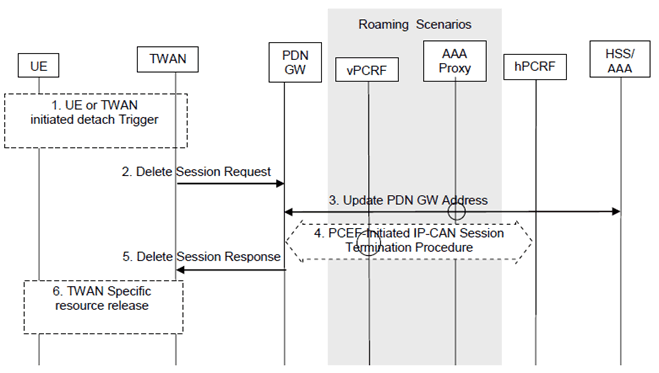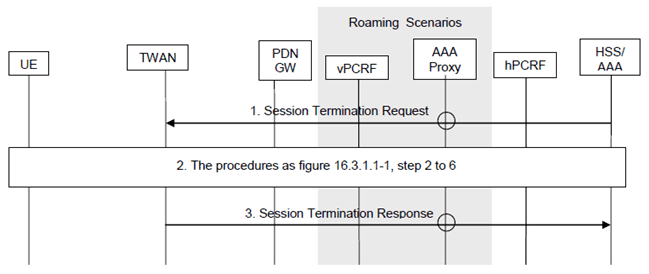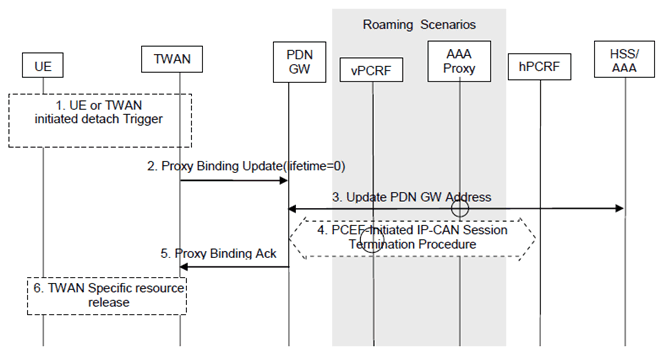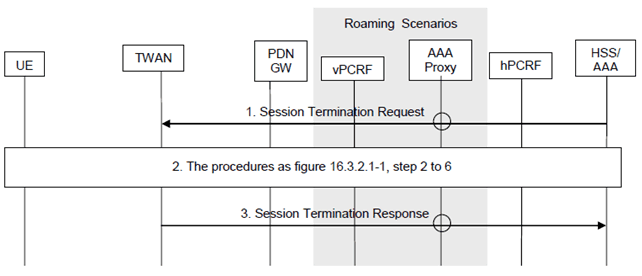Content for TS 23.402 Word version: 18.3.0
0…
4…
4.2…
4.2.2
4.2.3
4.3…
4.4…
4.5…
4.5.7…
4.6…
4.7…
4.7.2…
4.8…
4.8.2a…
4.9…
5…
5.2…
5.4…
5.5
5.6…
5.7…
5.8…
6…
6.2…
6.3
6.4…
6.4.3…
6.5…
6.6…
6.7…
6.8…
6.10…
6.13…
6.15…
7…
7.2…
7.3
7.4…
7.5…
7.6…
7.8…
7.10…
8…
8.2.1.2
8.2.1.3…
8.2.2
8.2.3…
8.2.6…
8.3…
8.4…
8.5…
9…
9.3…
9.4…
10…
13…
16…
16.1.2…
16.1.6…
16.2…
16.2.1a…
16.3…
16.4…
16.7…
16.8…
16.10…
17…
A…
C…
E…
16.3 Detach and PDN disconnection in WLAN on S2a
16.3.1 Detach and PDN disconnection in WLAN on GTP S2a
16.3.2 Detach and PDN disconnection in WLAN on PMIP S2a
...
...
16.3 Detach and PDN disconnection in WLAN on S2a p. 274
16.3.1 Detach and PDN disconnection in WLAN on GTP S2a p. 274
16.3.1.1 UE/TWAN Initiated Detach and UE/TWAN requested PDN Disconnection Procedure in WLAN on GTP S2a p. 274

Figure 16.3.1.1-1: UE/TWAN Initiated Detach and UE/TWAN requested PDN Disconnection on GTP S2a
(⇒ copy of original 3GPP image)
(⇒ copy of original 3GPP image)
The procedure for UE/ TWAN Initiated Detach is represented in Figure 16.3.1.1-1 and described below.
This procedure applies to the transparent single-connection mode. This procedure also applies to the single-connection mode with the exception that step1 refers to clause 16.7.1.1.
This procedure applies to the Non-Roaming, Home Routed Roaming and Local Breakout cases. In the Local Breakout case, the vPCRF forwards messages between the PDN-GW and the hPCRF. In the Home Routed Roaming and LBO cases, the 3GPP AAA Proxy serves as an intermediary between the Trusted Non-3GPP IP Access and the 3GPP AAA Server in the HPLMN. In the non-roaming and Home Routed Roaming case, the vPCRF is not involved at all.
If dynamic policy provisioning is not deployed, the optional steps of interaction between the PDN-GW and PCRF do not occur. Instead, the PDN-GW may employ static configured policies.
Step 1.
To detach from EPC, the UE can send a disassociation or deauthentication notification according to IEEE Std 802.11-2012 [64]. Any time after the UE releases the IPv4 address using DHCPv4 or IPv4 address lease time expires, and if the PDN Type is IPv4, the TWAN initiates "TWAN initiated PDN Disconnection Procedure" procedure. If there is no traffic received from the UE for a configurable duration and the TWAN detects the UE has left based on unanswered probes (e.g., ARP Request, Neighbor Solicitation message), the TWAN triggers PDN disconnection.
Step 2.
The TWAN releases the PDN connection by sending a Delete Session Request (Linked EPS Bearer ID, TWAN Release Cause if available) message for the PDN connection to the PDN-GW. Additionally, the Delete Session Request includes the TWAN Identifier as described in clause 16.1.7, the Timestamp of this TWAN-Identifier and the UE Time Zone. TWAN Release Cause is only sent by the TWAN to the PDN-GW if this is permitted according to TWAN operator's policy.
Step 3.
The PDN-GW informs the 3GPP AAA Server of the PDN disconnection. If the UE no longer has any context in the 3GPP AAA Server, the 3GPP AAA Server notifies the HSS as described in clause 12.1.2.
Step 4.
The PDN-GW deletes the IP-CAN session associated with the UE and executes a PCEF-Initiated IP-CAN Session Termination Procedure with the PCRF. If received from the TWAN, the PDN-GW shall also provide the TWAN Release Cause as well as, if available, the User Location Information that contains the TWAN Identifier and/or UE Time Zone and PCRF shall forward them to the Application Function as specified in TS 23.203.
Step 5.
The PDN-GW acknowledges with Delete Session Response (Cause).
Step 6.
The TWAN locally removes the UE context and deauthenticates and disassociates the UE at Layer 2 according to IEEE Std. 802.11-2012 [64].
16.3.1.2 HSS/AAA Initiated Detach Procedure in WLAN on GTP S2a p. 275

The procedure for HSS/AAA Initiated Detach from TWAN is represented in Figure 16.3.1.2-1 and described below.
This procedure applies to the transparent single-connection mode and the single-connection mode.
This procedure applies to the Non-Roaming, Home Routed Roaming and Local Breakout cases. In the Local Breakout case, the vPCRF forwards messages between the PDN-GW and the hPCRF. In the Home Routed Roaming and LBO cases, the 3GPP AAA Proxy serves as an intermediary between the Trusted Non-3GPP IP Access and the 3GPP AAA Server in the HPLMN. In the non-roaming and Home Routed Roaming case, the vPCRF is not involved at all.
Step 1.
The HSS/AAA sends a Session Termination Request message to the TWAN to detach a specific UE.
Step 2.
The step 2 to 6 of the UE/TWAN Initiated Detach procedure described in clause 16.3.1.1 are followed.
Step 3.
TWAN sends a Session Termination Response message to 3GPP AAA Server. If the detach procedure was initiated from the 3GPP AAA Server and if the UE no longer has any context in the 3GPP AAA Server, the 3GPP AAA Server communicates the HSS as described in clause 12.1.2. If the detach procedure was initiated by HSS, the 3GPP AAA Server replies to the HSS as described in clause 12.1.3.
16.3.2 Detach and PDN disconnection in WLAN on PMIP S2a p. 276
16.3.2.1 UE/TWAN Initiated Detach and UE/TWAN requested PDN Disconnection Procedure in WLAN on PMIP S2a p. 276

Figure 16.3.2.1-1: UE/TWAN Initiated Detach and UE/ TWAN requested PDN Disconnection on PMIP S2a
(⇒ copy of original 3GPP image)
(⇒ copy of original 3GPP image)
The procedure is similar to GTP based S2a call flows in clause 16.3.1.1, with the following differences:
- Step 2 is a Proxy Binding Update. The details of the Proxy Binding Update message are described in step 3 in clause 6.4.1.1. Additionally, the Proxy Binding Update includes the current TWAN Identifier as described in clause 16.1.7, the Timestamp of this TWAN-Identifier and the UE Time Zone.
- Step 5 is a Proxy Binding Acknowledgement. The details of the Proxy Binding Acknowledgement message are described in step 6 in clause 6.4.1.1.
16.3.2.2 HSS/AAA Initiated Detach Procedure in WLAN on PMIP S2a p. 276

The procedure is similar to GTP S2a call flow in clause 16.3.1.2, the difference is that step 2 refers to Figure 16.3.2.1-1.